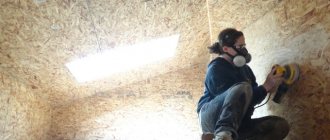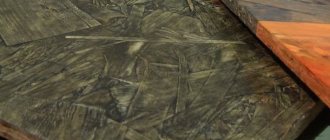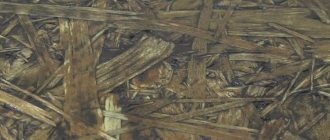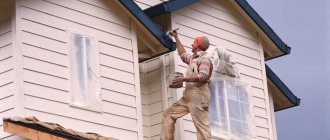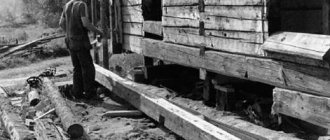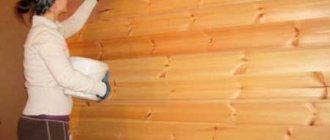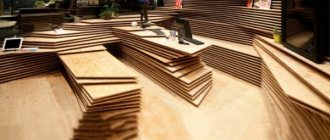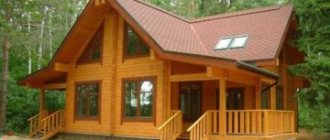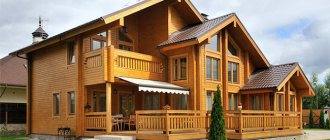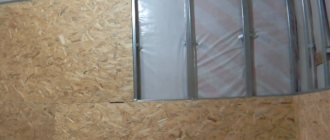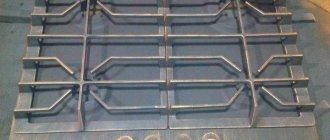Briefly about the material
Oriented strand board (OSB) consists of 90% natural wood in the form of large chips.
Crushed wood chips are joined together by gluing with different types of resins, polymers and adhesives. The result is a dense and hard material. But, as you know, natural wood is afraid of moisture and can swell under its influence. To protect the boards, they are impregnated with various chemical impregnations. The marking of the slabs depends on the type of impregnation used. Surely you noticed that the abbreviation OSB also has a number in the name. What does it mean?
- OSB-1 – has a minimum level of moisture-proof impregnations in its composition, therefore it is suitable for use only in dry, heated rooms.
- OSB-1 can withstand only short-term and minor exposure to moisture;
- OSB-2 – intended for finishing indoors with an average level of humidity;
- OSB-3 – able to withstand high levels of humidity, and even short-term wetness;
- OSB-4 is the most moisture-resistant category of material. Recommended for outdoor use.
Why do you need painting?
OSB boards are painted for many reasons.
- Firstly, a layer of paint forms a stable, dense film on the surface, which provides additional protection from exposure to excess moisture and ultraviolet rays;
- Secondly, some coloring compositions have a fairly dense texture, which allows you to completely smooth out the uneven surface of the slabs. Not many people like the pristine appearance of this finishing material;
- Thirdly, painting is the most cost-effective way to protect and decorate the surface of OSB boards. Often this reason plays a decisive role.
Varnish coating
The most suitable for protecting wood (and OSB) from moisture is the so-called yacht varnish on a urethane-alkyd or alkyd-urethane basis. Some of the popular brands:
- Tikkurila UNIKA SUPER (Finland). This brand is a leader in resistance to environmental influences, immunity to ultraviolet radiation and temperature changes.
- Marshall protex (Türkiye). Creates a plastic surface film.
- Marshall Protex Yat Vernik. It has increased wear and moisture resistance.
- PARADE (Russia). Keeps fresh for a long time.
- Belinka Yacht (Russia). It has dirt- and water-repellent properties, emphasizing the texture of wood materials.
- Antiseptic varnish for wood “Drevolak” on an acrylic base with the addition of wax (Russia). Along with antiseptic and antibacterial effects, it successfully protects wood from moisture.
Features of the material influencing the choice of paint
OSB boards can be called a specific material due to the pronounced texture of individual chips on the surface and some other features.
Before you start choosing a particular type of paint,
consider the following points:
- Without preliminary surface treatment, the paint may adhere poorly or unevenly to the base. This occurs due to poor adhesion or because the slabs are treated with special impregnations, which in turn form a film on the surface;
- It is not recommended to choose water-based compositions due to the fact that excess moisture can lead to swelling of the surface;
- A rough surface will require more paint;
- If the slabs are poorly painted even after careful preparation, it means they were stored incorrectly. Material that has been lying outside for more than one year must be thoroughly cleaned of dust and other contaminants, sanded and treated with antiseptics;
- At the ends, the slabs have a more porous structure; accordingly, they will require more paint to fill the voids. To avoid excessive consumption, it is recommended to pre-treat the seams.
Selection of compositions for interior painting
OSB boards are made from wood waste, so any coloring composition suitable for application to a wooden base is suitable for painting them.
When choosing paint for interior work, be sure to pay attention to its environmental friendliness.
The most suitable ones would be:
- Oil paints. They have a high level of viscosity, due to which they are practically not absorbed into the base. After complete drying, a very strong, but thin film is formed on the surface. The disadvantages of oil paints include long drying times and their instability to various atmospheric influences. That is why this option is used only for interior decoration;
- Alkyd paints and enamels. They are capable of penetrating deeply into the structure of slabs, filling voids, and forming a durable, moisture-resistant film on the surface. A surface painted with an alkyd composition does not require subsequent varnishing, which in turn reduces the cost of purchasing material. The coating will be durable and there will be virtually no unpleasant odor during operation. But keep in mind that alkyd paints are highly flammable;
- Clear or colored varnish. If you like the way the surface of the slabs looks, it is enough to cover them with transparent or colored varnish in several layers to provide protection from moisture and sunlight;
- Stain. Using this composition you can give the surface an aged effect. To do this, apply a thin layer of stain to the surface and then rub it with a piece of foam rubber. You can cover the surface completely, it all depends on preferences and the interior. A layer of varnish must be applied over the stain;
- Latex paint. This is a water-based composition with the addition of a synthetic rubber polymer. It can be used for interior decoration only if the walls are sheathed with OSB-3. It has the following advantages: moisture resistance, additional thermal insulation, cost-effectiveness due to the possibility of uniform distribution in a thin layer, short drying period, and safety for health. As for the disadvantages - not resistant to low temperatures, high cost. Also, the surface is prone to the formation of mold and fungi, and therefore requires additional impregnation. A thin layer of paint will not hide the characteristic texture of the slabs;
- Glazing azure. This is a water-based glazing composition that, after drying, forms a transparent or translucent film on the surface. The thickness of the coating is minimal, so it does not crack or peel over time. The use of such azure will preserve the structure of the slabs and give them an interesting shade.
How to create a patina effect?
Patination is a decorative technique that allows you to “age” a product. The patina looks beautiful and unusual. The patination process includes the following steps:
- Apply one or several layers of stain, previously diluted with acetone, to the surface. It can be diluted with water, but it does not evaporate so quickly, which significantly delays the work.
- Prime the treated oriented strand sheet.
- Apply a layer of patina to the work surface.
- Wipe the product with a dry sponge. This allows you to remove the patina from the protruding elements of the work surface and leave the paint only in its recesses.
- Varnish in several layers so that the decorated area does not change color and is not damaged by external factors.
How to paint an OSB facade?
stringent requirements are put forward for compositions intended for exterior finishing - they must be resistant to low and high temperatures, sudden temperature changes, humidity and ultraviolet rays.
In addition, you must decide how you ultimately want to see the facade of your house - matte or glossy, completely smooth or with a chip texture.
We mentioned that it is best to use OSB-4 boards for exterior finishing because of their resistance to moisture. This means that water-based paints and compounds can be used to coat them. Let's take a closer look:
- If you decide not to mask the structure of the slabs, then for the external coating you can use special paints with UV filters. In essence, these are ordinary varnishes, but on a different base - water-based, oil-based or acrylic. The main components of the composition are alkyd resins. The peculiarity of such acrylic-based varnishes is that after drying the surface becomes matte. There are also semi-matte compositions. Water-based varnish will be glossy. In order for the coating to be uniform, it is recommended to pre-treat the slabs with a water-based impregnation;
- The stain is also suitable for outdoor use. After the composition has completely dried, the surface must be primed and then covered with transparent varnish. This method of protecting the slabs will not hide their texture, but will make the appearance of the facade more interesting;
- Acrylic paint widely used for finishing facades. It creates a strong, wear-resistant film on the surface, fits well and is easy to apply on a rough base and has a wide range of colors. In addition to an interesting color, you can choose the level of gloss of the coating - matte, semi-matte, glossy. Acrylic paint is easy to work with - it does not spread during painting and dries quickly. Color fastness lasts for a long time even when exposed to direct sunlight. An important fact is that the protective coating is vapor and moisture permeable and resistant to sudden temperature changes. Painting can be carried out at any ambient temperature but lower than -20°C;
- Alkyd compounds are also suitable for use outside, if you do not mind their instability to alkalis and their ability to ignite quickly. The advantage of the composition is high strength and resistance to low temperatures;
- Silicone paint. Such compositions are the most expensive, but they can be called an ideal option for use outside the building. They are resistant to mechanical stress, cracking and peeling, and are moisture-repellent. Even if the OSB façade was previously painted with a paint of a different composition that has faded or peeled off, silicone paint can be applied over it.
Is additional processing needed?
The moisture resistance of oriented strand boards is characterized by the amount of thickness swelling during the day. According to this parameter, according to the American standard PS 2, European EN-300 and Russian GOST 10632-89, slabs are divided into 4 types (see table).
| Swelling value in thickness over 24 hours, % | |
| OSB-1 | 25 |
| OSB-2 | 20 |
| OSB-3 | 15 |
| OSB-4 | 12 |
Let us remind you that for the external cladding of a building it is allowed to use only OSB-3 and OSB-4 boards.
If the constructed structure is to be finished somehow, then during construction the OSB boards lie on the construction site in bundles. Even after one rain, the top few sheets swell almost one and a half times. They will remain like this after drying. The remaining sheets swell at the ends. By the way, to avoid this, the ends of North American products are painted with blood-red impregnation.
There is an opinion among some builders that OSB boards do not require additional processing, since they are already impregnated with resins, waxed, and varnished. Experience shows that after 2-3 years their appearance loses its original freshness, they darken, individual chips bulge here and there, and joints protrude sloppily.
Therefore, additional hydrophobic treatment will not be superfluous, especially if it is the facade of a residential building without any cladding. Let's consider how to treat OSB boards from moisture.
What is fire protection?
OSB boards burn as well as any wood product. During the combustion process, very caustic substances are released into the atmosphere, including poisonous hydrocyanic acid.
Often it is toxic smoke that leads to irreversible consequences. To increase the resistance of OSB to fire, special compounds called “fire-bioprotection” are used. The most common at the moment are 2 compositions:
- "Soppka". This is a paint with the addition of resins, which is designed specifically for application to OSB. Unlike conventional antiseptics, it is thicker and more viscous. After drying, a durable film is formed on the surface, which is not washed off in the rain due to the deep penetration of the composition into the structure of the base. The service life of the coating exceeds 15 years;
- "Valtti Color Satin". This is a high-quality facade glaze that has a high covering ability and protects wood from rotting.
Both compositions, in addition to fire protection, are also antiseptics that prevent the development of mold.
Transparent impregnations
The cheapest treatment option is water-repellent colorless impregnations. There are no special solutions for OSB. You can use any wood products, with the exception of water-based ones. Examples of such compositions:
- Elcon silicone-based antiseptic impregnation for wood. Designed for long-term protection of wooden structures from weathering, rot, and mold. Scope of application: for interior and exterior work. Forms a water-repellent film, non-toxic, allows the wood to “breathe”.
- Innovative domestic hydrophobizing composition NEOGARD-Tree-40 based on organosilicon oligomers. Designed to impart water-repellent properties to products made of wood and wood-based materials: plywood, chipboard, fiberboard. Water absorption for chipboard is reduced by 15 - 25 times. Obviously, it is also suitable for OSB. Does not change the natural color of the material, the protective properties remain for at least 5 years.
Slab preparation and painting technology
Correctly carried out preparatory work is the key to a good result.
Indoor painting work can be divided into 4 main stages:
- Leveling the surface. Produced by grinding. Sanding allows you to smooth the surface of the slab and make it unrecognizable. The most convenient tool is to use a grinder with a grinding wheel. You don't have to use a lot of force, just a light touch is enough. Particular care must be taken to sand the surface of OSB-3 and OSB-4 boards in order to remove the protective wax coating, which prevents the primer from penetrating into the structure and reduces adhesion to the paint and varnish composition;
- Sealing joints. It is best to fill the seams between the plates and the places where screws are attached with an elastic putty compound. If there is a need to create the effect of a monolithic surface and disguise the joints in the color of the slabs, add sawdust remaining after trimming the sheets to the putty. If after drying you see that the composition has come out beyond the seams, the surface can be sanded. If you need to make a perfectly smooth surface for a single-color painting, the seams can be taped with a special airtight “Rapid Cell” tape;
- Padding. Once you remove the top layer of material, the internal pores will open. OSB board shavings are combined using various resins, waxes and paraffins, which prevent the process of rotting. These substances must remain inside the structure. To “seal” the pores, special barrier primers are used, for example FI M194, which must be applied from a sprayer. The soil must be allowed to dry completely;
- Application of coloring composition. If we are talking about painting the facade, then after the priming stage it is necessary to fix the fiberglass mesh along the entire perimeter, fill the surface with a moisture-resistant and frost-resistant composition, and only after it has dried, start applying paint. It is recommended to carry out work in dry, windless weather.
Unusual dyeing methods
No matter how carefully you polish the surface of the slabs, it is very difficult to completely mask its characteristic pattern using ordinary paint.
This type of finish is not suitable for every interior. Therefore, there are several ways to perform decorative painting.
Imitation of stone surface
This technology will require a lot of time and patience, as it involves multi-layer painting.
- First of all, draw or download from the Internet an image with the desired stone pattern. Do not choose too intricate textures, they will be difficult to reproduce;
- Determine how many colors you will need and paint the desired surface with a base color primer paint. Usually the lightest shade is used as the base shade. Please note that the surface does not need to be sanded. To ensure that the paint is evenly distributed over an uneven surface, it is best to apply it using a spray gun;
- After the paint has dried, lightly clean the surface to emphasize the relief and make it deeper;
- Using a pencil, transfer the outline of the stonework from the image to the floor surface;
- Now paint the outline with a thin brush and darker paint;
- After this, individual “pebbles” can be additionally tinted with other colors to add volume;
- After this, update the outline in the right places;
- After the paint has dried, the result is secured with varnish.
Painting with plaster effect
This method does not require the performer to have artistic talent.
- First of all, the surface needs to be sanded. The purpose of sanding is only to remove the layer of wax protective coating;
- Padding;
- Application of pigment primer. The color should be chosen based on personal preferences;
- To obtain a pattern like in our photo example, a white primer was used;
- After the soil has completely dried, the surface is ground again, but using a wheel with a finer grain;
- Removing dust from the surface;
- Next, you can apply a composition with the effect of mother-of-pearl or patina, or you can do both, but in turn. Each composition must dry before applying the next. Patina will give an aging effect. After applying it, you need to wait 5-7 minutes and walk over the surface with a block of sandpaper;
- Clean the surface from dust;
- Secure the result by applying clear or tinted varnish.
The article was written for the site.
Tags: Enamels and paints
